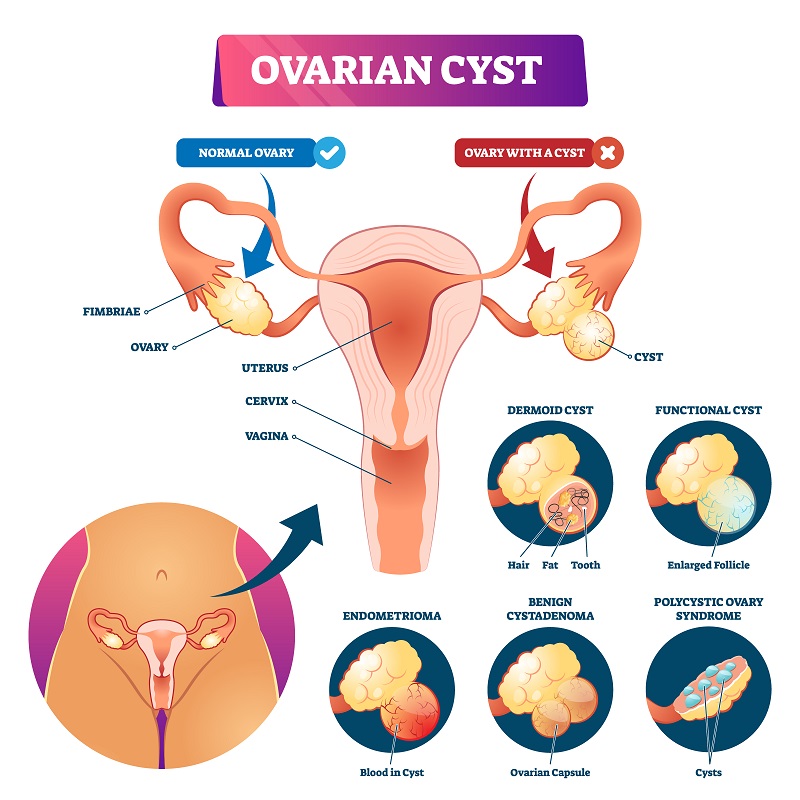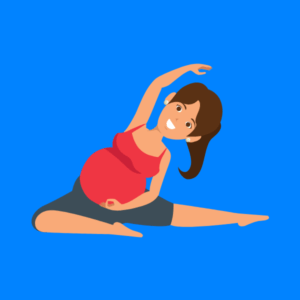Ovarian cysts are mostly fluid filled sacs in the ovary. They are very common and usually happen if you have regular periods. Most don’t usually present with symptoms and are harmless.
Different types of Ovarian cysts:
⦁ Functional cysts : These are the most common type of cysts which are called follicle and Corpus Luteum cysts. Around ovulation, an egg bursts out of its follicle and travels down the fallopian tube.
A follicular cyst begins when the follicle doesn’t break open or release its egg, but the fluid inside the follicle then forms a cyst on the ovary
On the other hand, when a follicle releases its egg, it begins producing estrogen and progesterone for conception. If the follicle sacs don’t dissolve after releasing the egg, it then forms the corpus luteum cyst.
Functional cysts are usually harmless, hardly cause pain, and often disappear on their own within two or three menstrual cycles.
- Dermoids come from cells present from birth, usually contain fat, hair and other tissue, do not usually cause symptoms and rarely turn cancerous.
- Cystadenomas develop on the surface of the ovary are filled with watery/mucous fluid and can sometimes grow large.
- Endometriomas: happens when the lining of the uterus (womb) grows outside of the uterus and some of these tissues begin to attach itself to the ovaries, forming a cyst.
- PCOS can cause many small cysts to form on the varies and is often diagnosed when women have irregular periods or have been unable to get pregnant.
- Malignant cysts are more common in older women and is normally called ovarian cancer. They are caused by abnormal cell growth and are not related to the menstrual cycle
Risk factors/causes for ovarian cysts
- Hormonal problems. Functional cysts may be cause by hormonal problems or using drugs (Clomid), which is used to cause you to ovulate.
- Pregnancy: Sometimes, the cyst that forms when you ovulate stays on your ovary when pregnant to help support it till placenta forms.
- Endometriosis: is when some of the endometrial tissue attach to your ovary and form a growth.
- A severe pelvic infection. If the infection spreads to the ovaries, it can cause cysts.
Symptoms of Ovarian cysts
Most ovarian cysts are small and don’t cause symptoms. If it does cause symptoms, it includes: pressure, pelvic pain, dull ache in lower back and thighs, pain during sex, bloating, swelling, or pain in the lower abdomen on the side of the cyst. This pain may be sharp or dull and may come and go.
Sudden severe pain if a cyst ruptures, or nausea and vomiting if the cyst causes twisting of the ovary.
How are they diagnosed?
⦁ Pelvic ultrasound: With ultrasound, your doctor can visualise the ovary and see the cyst’s size, location, shape and whether its fluid or solid or mixed.
⦁ Pregnancy test: to rule out pregnancy and if you are , it should be a corpus luteum cyst.
⦁ CA 125 blood test. Women who have Ovarian cancer have elevated blood levels called cancer antigen 125 (CA 125) often are elevated in women with ovarian cancer. Your doctor might order this test if your cyst is partially solid and you’re at high risk of ovarian cancer. Though a high CA125 could be caused by other benign conditions.
⦁ Hormone level tests to see if there are hormone-related problems
Treatment of Ovarian cysts
⦁ Watchful waiting. This is usually recommended if the ultrasound shows you have a simple, small, fluid-filled cyst as they usually go away after some cycles. You may be told to get follow up pelvic ultrasounds to see if it changes in size.
⦁ Your doctor might recommend birth control pills, to keep ovarian cysts from recurring
⦁ Laparoscopy or laparotomy. Using a laparoscope under anaesthesia— your doctor can use a small, lighted instrument inserted into your abdomen through a tiny incision near your navel to remove the cyst. A laparoscopy is preferred because it causes less pain and has a quicker recovery time.
During a laparotomy, a single, larger cut is made in your tummy to give the surgeon better access to the cyst.
Your doctor will try to preserve as much of your sexual organs as possible in case you may still want to get pregnant in future. Even if they do take out one ovary (oophorectomy), the remaining ovary will still release hormones and eggs as usual, though may take longer to get pregnant.
If your test results show that your cyst is cancerous, a hysterectomy may be performed where both of your ovaries, your womb and some of the surrounding tissue may need to be removed.



